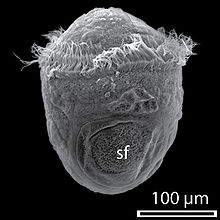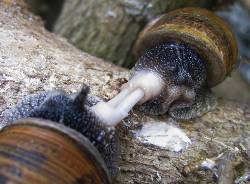Life Cycle of a Snail
It's a snail's life
Online Biology Dictionary|
|

|
|
Snail eggs on a stalk of grass.
Image: Veer |

|
|
A typical trochophore Image: Daniel J. Jackson |

|
| Hermaphroditic snails mating (Garden Snail, Helix aspersa) Image: Carla Isabel Ribeiro |
The life cycle of a terrestrial snail is straightforward. There is no metamorphosis with markedly distinct larval and adult forms, as in such organisms as frogs or butterflies.
The young snail within the egg has a shell and the same basic form as an adult. The shell is transparent initially, but becomes opaque soon after hatching, when the snail starts eating food containing calcium. Thereafter, the snail looks like a small version of an adult. From the beginning, a snail adds layers to the rim of its shell so that it grows in a coil, round and round, larger and larger.
But most sea snails differ from land snails in that they have a larval stage, known as a trochophore (see figure right), that differs greatly in appearance from that of the mature animal (Margulis et al. 2011, p. 188), just as a maggot looks very different from a fly. Trocophores are planktonic and use their cilia to swim.
After reaching maturity, both female and hermaphrodite snails lay eggs (see upper image at right). In those snails where separate sexes exist, males fertilize the eggs produced by females. Hermaphrodites usually mate with each other, but self-fertilization can occur.
However, in many hermaphroditic snails, for example the Garden Snail, Helix aspersa (see image), the spermatozoa develop so much earlier than the ova that they are absent when fertilization needs to take place. Under such circumstances mating with another individual must take place if reproduction. Hermaphrodites of this kind are called protandrous.
Some snails are even parthenogenetic, that is, their eggs develop without fertilization.
At any rate, by one or another of the methods listed above, the eggs are produced. The life cycle of a snail then begins again.
| Online Biology Dictionary >> |
Snail facts:
- Snails make up the molluscan class Gastropoda;
- All land snails are hermaphroditic;
- Some snails, such as the Maiden Campeloma (Campeloma parthenum), reproduce via parthenogenesis.
- A few snails, such as the Japanese Trapdoor Snail (Viviparus malleatus), give live birth, but the great majority are oviparous.
Most shared on Macroevolution.net:
Human Origins: Are we hybrids?
On the Origins of New Forms of Life
Mammalian Hybrids
Cat-rabbit Hybrids: Fact or fiction?
Famous Biologists
Dog-cow Hybrids
Georges Cuvier: A Biography
Prothero: A Rebuttal
Branches of Biology
Dog-fox Hybrids